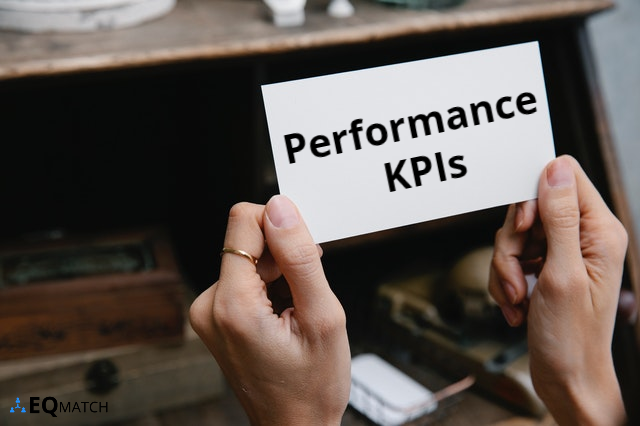Peter Drucker nailed it when he said- If you can’t measure it, you can’t change it.
Without data and measurement, it is difficult to gauge the performance of a business, HR being no exception. If you do not know whether or not you are making progress towards your strategic HR goals, you have a problem.
That is why human resource KPIs are critical to the success of any business, small or large.
Key Performance Indicators or KPIs help evaluate the success of an organization.
Human Resource Key Performance Indicators Examples
Broadly speaking, human resource management KPIs can be divided into two areas- quantitative and qualitative.
Quantitative KPIs involve numerical measures and not subjective standards.
The number of FTEs (full-time employees), for instance, is a quantitative KPI.
Customer satisfaction scores, on the other hand, is an example of a qualitative KPI- subjective criteria.
It takes understanding and a little discipline to only measure the most important things, hence the term, Key Performance Indicators (KPIs).
Top Human Resource Trends That Will Shape the Future
As an HR professional, you want to measure only those metrics that matter the most.
Your measures should be aligned with your strategic goals.
Ideally, the best KPIs should be a combination of both qualitative and quantitative metrics.
Using a combination of qualitative and quantitative KPIs can improve HR evaluation.
This is because using this approach you can ensure that the limitations of one type of data are balanced by the strengths of another.
What are the most important hr key performance indicators?
There are four important HR KPI segments that you should observe- Culture, Compensation, Performance, and Employment.
In this article, we will talk briefly about these four human resource KPI metrics.
Let’s start with Culture KPIs.

Culture KPIs
Employee Satisfaction/NPS: This is an aggregate KPI that measures how happy and engaged your employees are at any given time.
This KPI is one of the most important metrics to address in order to reduce your employee turnover rates and keep your labor costs down.
Employee Churn/Turnover: High churn equals an opportunity to improve company culture.
You can calculate this KPI by dividing the total number of employees who left the company by your average number of employees in a given period.
Utilization Rate: This KPI helps understand job satisfaction. Put simply, the utilization rate is calculated by dividing the hours an employee spent on client work by their total hours worked.
Put another way, it is the percentage of an employee’s total working hours spent doing work that can be billed vs. administrative tasks.
Revenue per Employee: This is an important KPI that measures how much money each employee generates for the business.
For example, the energy sector had the highest average revenue per employee in the United States in 2018, boasting of an average revenue of USD 1.79 million per employee.
Here is an even better data-set:

Let’s move on to the next category of Human Resource KPIs- compensation

Compensation KPIs
This helps measure and analyze the effectiveness of your compensation practices and policies.
HR professionals should carefully examine these KPIs to make informed decisions to attract and retain employees.
Employee Productivity Rate: This is calculated by dividing the total company revenue by the total number of employees.
This metric helps measure workforce efficiency over time.
As per Gallup, businesses lose $483 to $605 billion per year in productivity due to actively disengaged employees.
Salary competitiveness ratio (SCR): This HR KPI helps measure the competitiveness of the current salary at your organization for specific job roles.
You can measure salary competitiveness against specific competitors or against the industry/market.
A higher SCR means your organization has a competitive edge over your competitors.
Percentage of Cost of Workforce: This KPI helps HR professionals make informed decisions related to wages, promotions, hiring, and training.
You should account for salaries, training & recruitment costs, benefits, and bonuses; taxes, insurance, vacation, and overtime pay while calculating the percentage of the cost of the workforce.
Benefits Satisfaction: This is a qualitative HR KPI that helps you assess how satisfied an employee is with specific benefits they receive.

Employment KPIs
Absenteeism Rate or Absence Percentage: is defined as the rate of unplanned absence due to sickness or other causes. You can measure this KPI for an employee, a team, or the entire company.
It is calculated by dividing the total number of lost workdays due to absence by the number of workdays.
Cost per Hire: This KPI helps you assess the time and money invested in acquiring the best talent.
You can calculate this KPI by dividing the sum of all recruiting costs by the number of hires in a specific time period.
The average cost per hire is $4,425.
Average Time to Hire: It takes 36 to 42 days to fill an average position in the United States.
Emotional Intelligence Tests Can Help HR Managers Hire Right
There are several more employment KPIs such as the number of FTEs/contractors, voluntary termination rate, the average rate of retirement, hiring process satisfaction rate, yield percentage, and acceptance rates.

Performance KPIs
New Hire Performance: HR professionals can use performance reports to compare the performance of new hires with that of other employees.
Internal Promotion Rate: This KPI helps assess the state of employee retention in your company. It is calculated by dividing the number of promoted individuals by the total number of employees.
Rate of Internal Job Hires: Shows the effectiveness of organizational talent development.
Rate of Internal Referral Hires: Allows managers to see the value-added when current employees help to identify and acquire talent.
Internal Promotions vs External Hires: This KPI comes handly especially when looking at organizational succession planning.
We will cover the exhaustive list of performance KPIs in a separate blog.
Download our Human Resource KPI dashboard template FREE
Choosing the right KPIs: Be S.M.A.R.T
Your HR KPIs should be Smart, Measurable, Attainable, Relevant, and Time-Bound.
Different organizations would have a different set of KPIs. Here is an example.
Some organizations might focus on the average tenure of employment. On the surface, this might sound like a good metric to measure.
However, reflecting upon it using the S.M.A.R.T. methodology, you will notice that while this metric is measurable and attainable, it is not smart, relevant, or time-bound.
This KPI does not reflect the productivity or efficiency of an employee, after all.
Compare this KPI with the internal promotion rate (IPR). The IPR fulfills all areas of the S.M.A.R.T. methodology- it is measurable, attainable, relevant, and time-bound.
The internal promotion rate shows how employees in a company develop their skills, and how they progress over time. It also helps businesses save money since external heroes cost time and money.
Conclusion
Like other business areas, the Human Resource Management department needs to be data-driven in order to recruit, train, and retain top talent. Aligning your human resource KPIs with strategic business goals can help you save much time, effort, and money.





No responses yet